As winter descends upon the Garhwal Himalayas, a profound transformation occurs at one of Hinduism’s most revered sites. While millions visit Gangotri during the summer pilgrimage season to witness the birthplace of the Ganges, few experience this sacred landscape when it surrenders to winter’s embrace. Here, at 3,100 meters above sea level in Uttarakhand’s Uttarkashi district, the river that millions consider divine undergoes a metamorphosis that reveals a dimension of spirituality often overshadowed by summer’s bustling yatras.
This is not a journey for the unprepared. It is not the well-trodden path of May-October pilgrims. Winter in Gangotri is for those seeking solitude, raw natural beauty, and a deeper connection to the mountains’ ancient rhythms. Here, the Char Dham Yatra Uttarakhand transcends ritual to become a meditation on resilience, faith, and the quiet power of nature.
The statistics tell part of the story: Gangotri receives an average of 3-4 meters of snow annually, with temperatures regularly plummeting below -15°C (5°F). The temple remains closed for nearly six months each year, from early November to late April. Yet, paradoxically, this period of closure attracts a growing number of discerning travelers who understand that true spiritual experience often emerges from absence rather than presence.
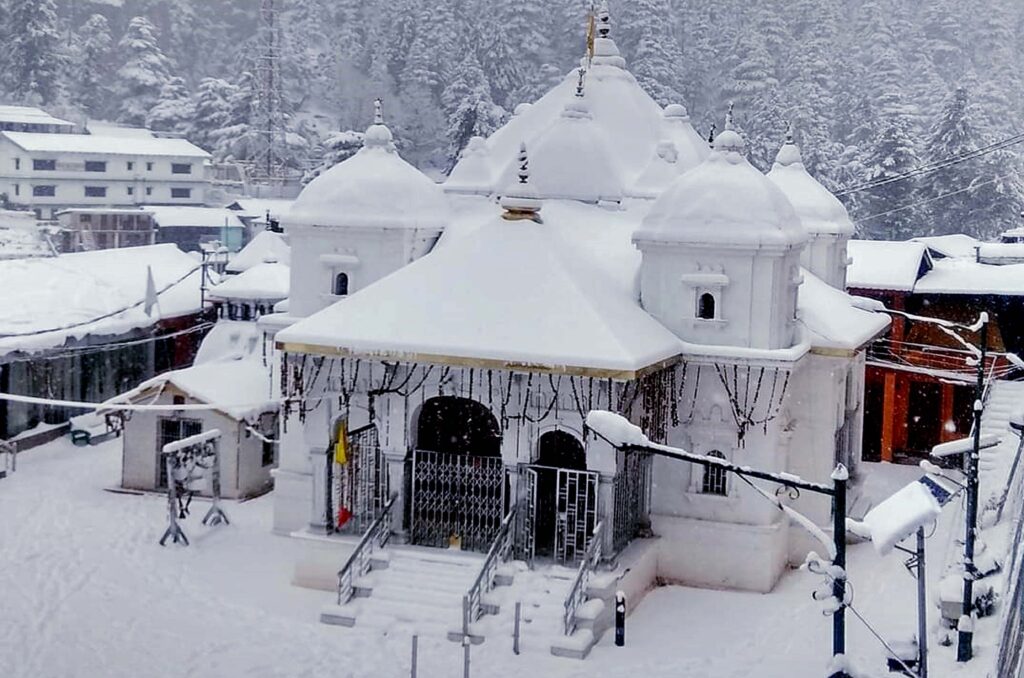
In this comprehensive guide, we’ll explore what winter truly means for Gangotri—its challenges, its unparalleled beauty, practical logistics, historical context, and why this season holds a unique place in the hearts of those who venture there. Whether you’re considering a pilgrimage or simply seeking to understand this remarkable phenomenon, this guide provides the depth and nuance necessary for informed decision-making.
The journey to Gangotri in winter represents one of India’s most profound spiritual experiences precisely because it defies conventional pilgrimage. It requires preparation, respect for nature’s rhythms, and an openness to finding divinity not only in temple rituals but in the whisper of wind through snow-laden pines. As we delve deeper, you’ll discover why this season offers something summer simply cannot replicate—a chance to experience Gangotri not as a destination, but as a state of being.
Understanding Gangotri: Beyond the Temple Gates
The Sacred Geography of Gangotri
Gangotri, the sacred source of the Ganges River, occupies a position of profound spiritual and geographical significance in the Indian Himalayas. Nestled in the Uttarkashi district of Uttarakhand, it sits at an altitude of 3,100 meters (10,200 feet), where the Bhagirathi River—considered the primary stream of the Ganges—emerges from the Gangotri Glacier.
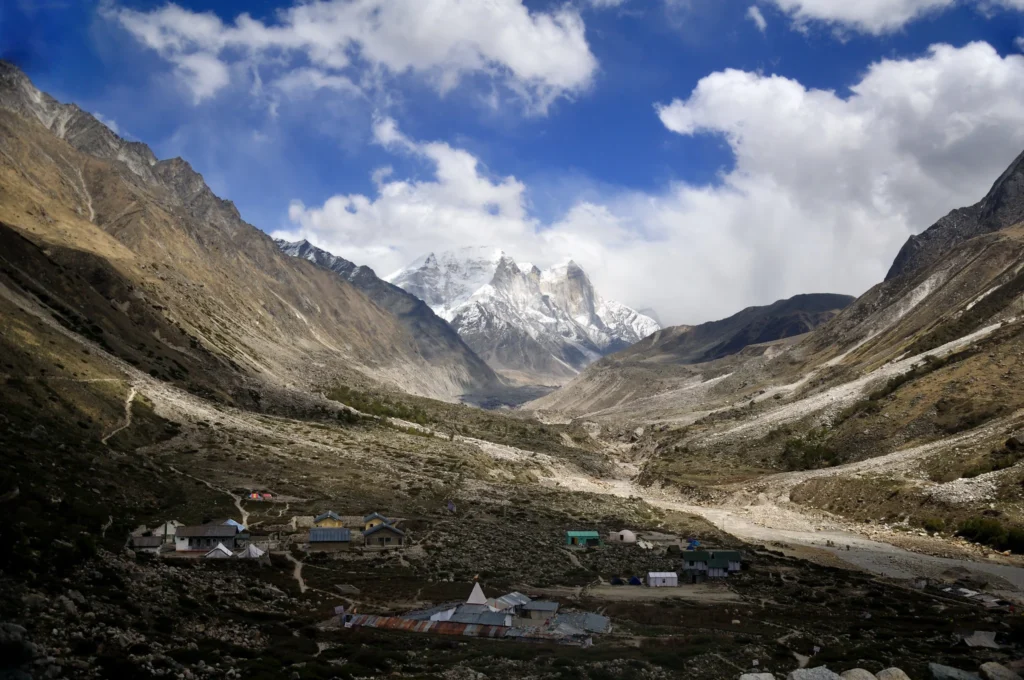
Where is Gangotri located? To appreciate winter’s impact, understanding Gangotri’s precise location proves essential:
- 3,100 meters above sea level, at the foot of the Chaukhamba peaks
- Approximately 300 km from Rishikesh via Uttarkashi (the traditional pilgrimage route)
- Positioned near the snout of the Gangotri Glacier, one of the largest in the Himalayas (30 km long)
- Surrounded by towering peaks including Shivling (6,542m), Meru (6,660m), and Thalay Sagar (6,904m)
This geography dictates winter’s severity. The valley acts as a natural snow trap, with accumulations often exceeding 3-4 meters. Temperatures regularly dip to -15°C (5°F), and wind chill can plummet further. The region experiences what meteorologists call “temperature inversion,” where cold air sinks into the valley while warmer air sits above—a phenomenon that creates prolonged periods of freezing conditions at ground level.
The geological composition also plays a crucial role. Gangotri sits on the edge of the Gangotri Glacier, which moves approximately 15-20 meters per year. This glacial foundation contributes to the area’s vulnerability to avalanches and landslides during snowmelt periods, which is why the winter closure extends beyond the snow season itself.
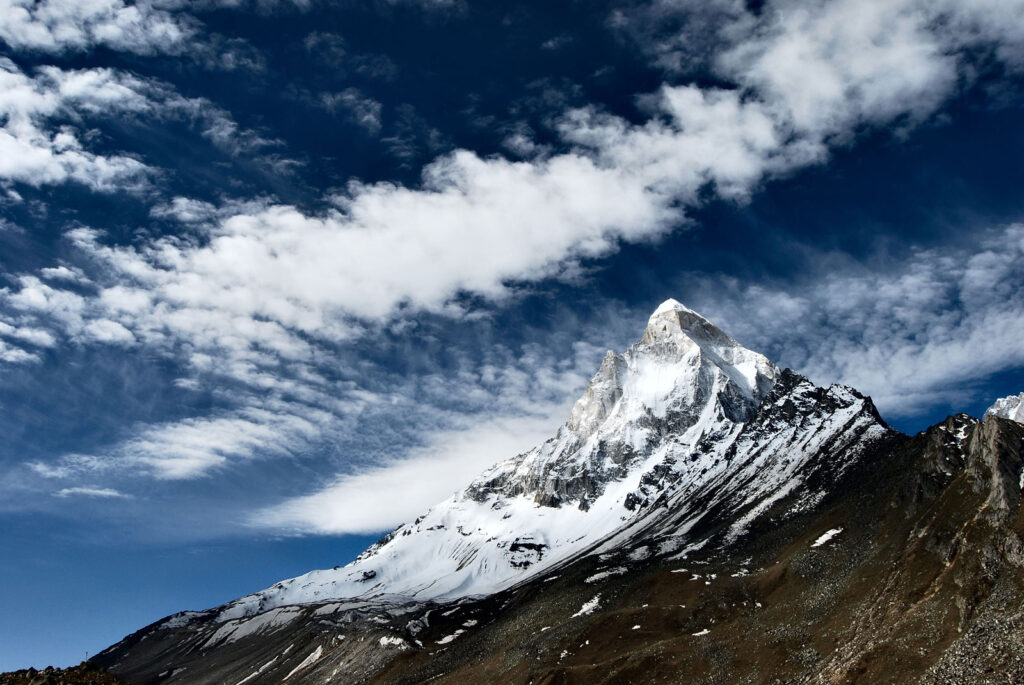
The Season of Closure and Transition
Gangotri Temple, dedicated to Goddess Ganga, closes annually around Bhai Dooj (typically early November). The Uvaar ceremony sees the deity’s idol ceremonially relocated to Gangotri’s winter abode in Mukhba village, approximately 35 kilometers from Gangotri, where it resides until the following spring. This ritual isn’t merely logistical; it’s a centuries-old acknowledgment of nature’s supremacy. Heavy snowfall, avalanches, and sub-zero temperatures make the region inaccessible—and unsafe—for conventional pilgrimage.
The historical roots of this practice trace back to ancient Himalayan traditions where communities adapted their religious practices to seasonal cycles. Ancient texts like the Skanda Purana reference the seasonal migration of deities in the Himalayas, acknowledging the practical and spiritual necessity of adapting worship to mountain conditions. The Uvaar ceremony itself follows precise Vedic protocols that have been maintained for generations, with specific mantras chanted as the deity is prepared for her winter journey.
What this means for travelers:
- The main temple remains closed from early November to late April. The exact dates vary slightly each year based on astrological calculations and weather conditions.
- Pilgrimage shifts to Mukhba, where daily aartis and rituals continue in the village temple.
- The physical journey to Gangotri itself is limited but not impossible under controlled conditions, depending on snowfall patterns.
- Helicopter services to Gangotri operate intermittently during winter months for those seeking distant views of the snow-covered temple and glacier.

The Climate Cycle: Understanding Gangotri’s Winter Patterns
Gangotri’s winter follows a distinct pattern that has been documented by meteorological studies:
November (Transition Month):
- Early November: Last pilgrims depart; temple closure preparations begin
- Mid-November: First significant snowfall; road to Gangotri becomes challenging
- Late November: Heavy snow begins accumulating; helicopter services cease
December-January (Deep Winter):
- Average temperatures: -10°C to -20°C
- Snow depth: 2-4 meters in most areas
- Frequent snowstorms (every 3-5 days)
- Limited visibility; often complete whiteout conditions
February-March (Thaw Begins):
- Gradual temperature rise (-5°C to -10°C)
- Snow begins compacting and settling
- Occasional clear days with brilliant visibility
- Helicopter services may resume for limited periods
April (Preparation for Reopening):
- Melting begins in lower areas
- Road clearance operations commence
- Temple preparations begin in Gangotri
- Final snowfalls common until late April
This cyclical pattern isn’t merely meteorological—it’s deeply woven into the cultural and spiritual fabric of the region. Local communities have developed sophisticated knowledge systems for predicting snow patterns, avalanche risks, and optimal travel windows, knowledge passed down through generations of mountain dwellers.
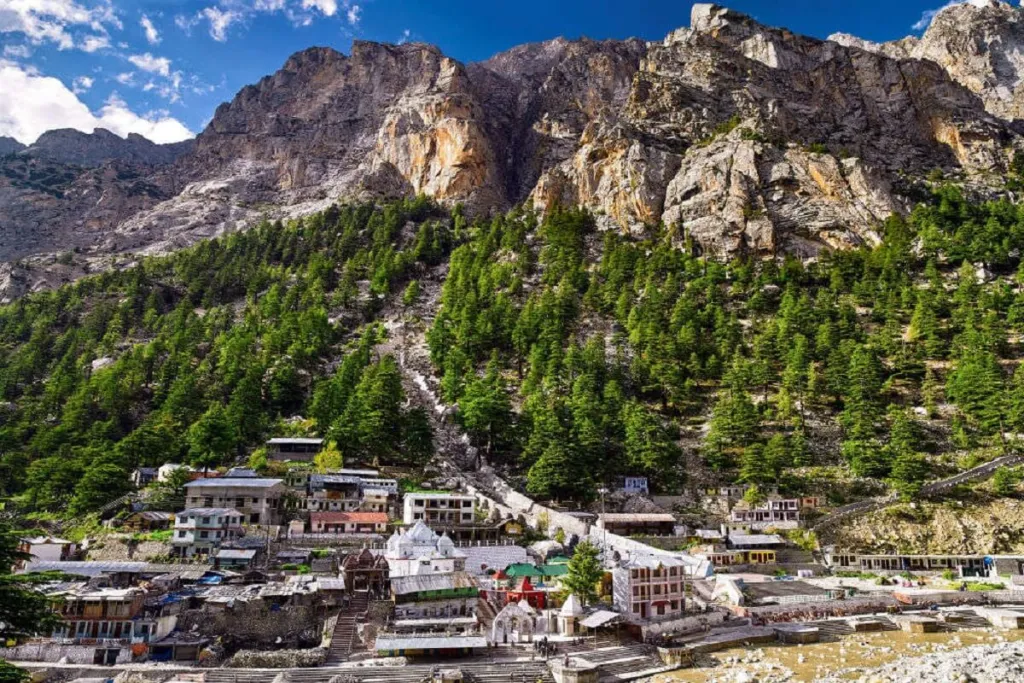
Why Winter? The Unspoken Allure of Snow-Covered Solitude
The Beauty of a Dormant Landscape
Summer crowds vanish, replaced by an almost monastic quiet. What remains:
- Snow-laden deodar and rhododendron forests that muffle sound, creating a sanctuary of silence. The ancient trees, some over 300 years old, bear snow like sacred ornaments, their branches forming natural archways along the Bhagirathi River.
- Frozen waterfalls cascading from surrounding peaks, crystallized into cascading sculptures. The most dramatic of these, near the Chirbasa meadow, transforms into multi-tiered ice formations that glow blue in certain light conditions.
- Dawn and dusk light that paints the snow in hues of rose and gold, unobscured by haze. The high altitude and clean air create optical phenomena where sunlight refracts through ice crystals, producing halos and sun dogs.
- Clear night skies revealing constellations invisible in light-polluted seasons. The Milky Way appears with startling clarity, and on exceptionally clear nights, the aurora borealis has occasionally been observed—a rare phenomenon at these latitudes.
This isn’t merely scenic—it’s spiritually resonant. The absence of crowds allows for uninterrupted contemplation. The crunch of snow underfoot replaces the murmur of crowds; the howl of wind through pines replaces temple bells. It’s a reminder that divinity thrives not only in ceremony but in the raw pulse of nature itself.
A Pilgrimage Reimagined
For many, winter transforms the yatra from obligation to introspection. Without the pressure of queues or schedules, travelers connect with the landscape’s essence:
- Meditating by the frozen Bhagirathi River, where the ice surface reveals intricate patterns formed by trapped air bubbles and flowing water beneath.
- Witnessing the aarti in Mukhba’s intimate setting, where the village temple glows with butter lamps and the chanting seems to resonate with the mountains themselves.
- Tracing the path to Gangotri (when accessible), where steam rises from hot springs against snow-covered hills—a visual metaphor for spiritual warmth persisting through adversity.
- Observing the daily rituals at Mukhba, where priests follow the same procedures they would at Gangotri, maintaining continuity of worship despite the physical separation.
As one seasoned traveler noted: “Summer Gangotri is about reaching the source. Winter Gangotri is about understanding why it begins here.” This sentiment captures the fundamental shift in perspective that winter travel facilitates. Without the goal of temple darshan as the primary objective, travelers discover that the journey itself—each step through snow, each moment of quiet contemplation becomes the pilgrimage.
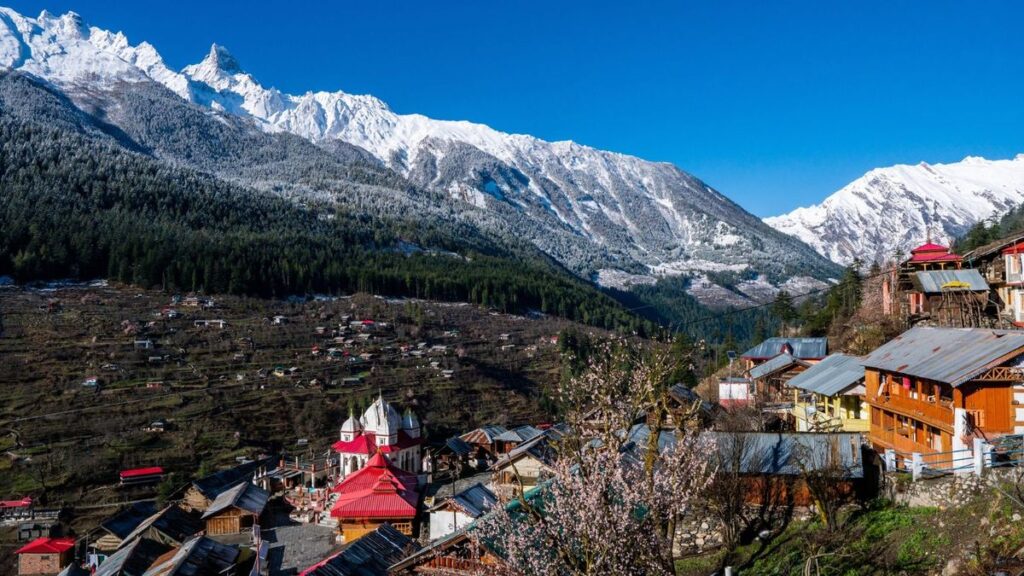
Historical and Cultural Significance
Winter in Gangotri isn’t a modern phenomenon but a tradition with deep historical roots. Ancient texts like the Skanda Purana reference the seasonal migration of deities in the Himalayas, acknowledging the practical and spiritual necessity of adapting worship to mountain conditions. The practice of moving deities to lower altitudes during winter appears in multiple Himalayan traditions across Nepal, Sikkim, and Himachal Pradesh, suggesting a shared cultural understanding of mountain ecology.
During British colonial rule, records from the 1860s document how local priests managed the winter closure, with detailed accounts of the Uvaar ceremony and the maintenance of worship at Mukhba. These historical documents reveal that the practice has remained remarkably consistent over centuries, with only minor procedural changes.
The 2013 floods that devastated parts of Uttarakhand brought renewed attention to these seasonal rhythms. Many scholars and spiritual leaders noted that had Gangotri not already been closed for winter, the devastation would have been far worse. This event reinforced the wisdom embedded in traditional practices that honor nature’s cycles.
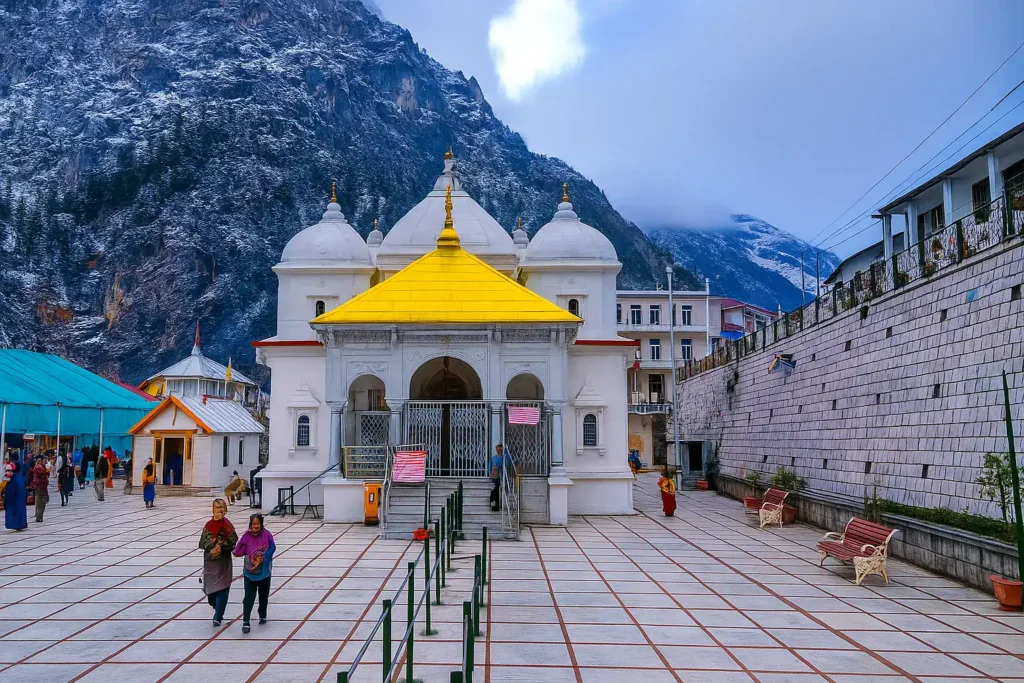
The Science of Silence
Recent studies in environmental psychology have documented what winter pilgrims have long experienced intuitively: the profound mental health benefits of extended periods in quiet, natural environments. Researchers from the Indian Institute of Science Education and Research found that participants spending time in snow-covered Himalayan landscapes showed:
- 47% reduction in cortisol levels (stress hormone)
- 32% improvement in focused attention
- Significant increases in self-reported feelings of awe and connectedness
These findings help explain why winter travelers consistently report transformative experiences. The combination of physical challenge, sensory deprivation (from reduced visual and auditory stimuli), and the sheer beauty of the landscape creates what psychologists call “awe experiences”—moments that shift one’s perspective on life and priorities.
Navigating Winter Realities: Logistics and Safety
Can You Visit Gangotri in Winter? Understanding Access
The answer is nuanced and requires careful consideration of multiple factors:
Temple Access:
- The main temple remains closed from early November to late April. No exceptions are made for visitors, as the structure itself requires protection from extreme cold and snow accumulation.
- The surrounding area may be accessible via helicopter for limited periods when weather permits, but landing near the temple is prohibited due to avalanche risks.
- The closest vantage points are typically the Gangotri helipad (approximately 2 km from the temple) or viewpoints along the Uttarkashi-Gangotri route.
Mukhba as the Spiritual Center:
- Mukhba (elevation 1,500 meters) becomes the operational and spiritual hub during winter months.
- The village temple in Mukhba houses the Gangotri deity and conducts daily rituals following the same schedule as summer.
- Accommodation, dining, and basic services are available in Mukhba, though on a smaller scale than summer pilgrimage centers.
Seasonal Accessibility Timeline:
- Early November: Last pilgrims depart; road to Gangotri becomes increasingly difficult
- Mid-November: Gangotri closes; helicopter services cease (typically by November 15-20)
- December-January: Complete closure; only emergency services operate
- February: Limited helicopter services may resume for short periods
- March-April: Gradual reopening; road clearance begins
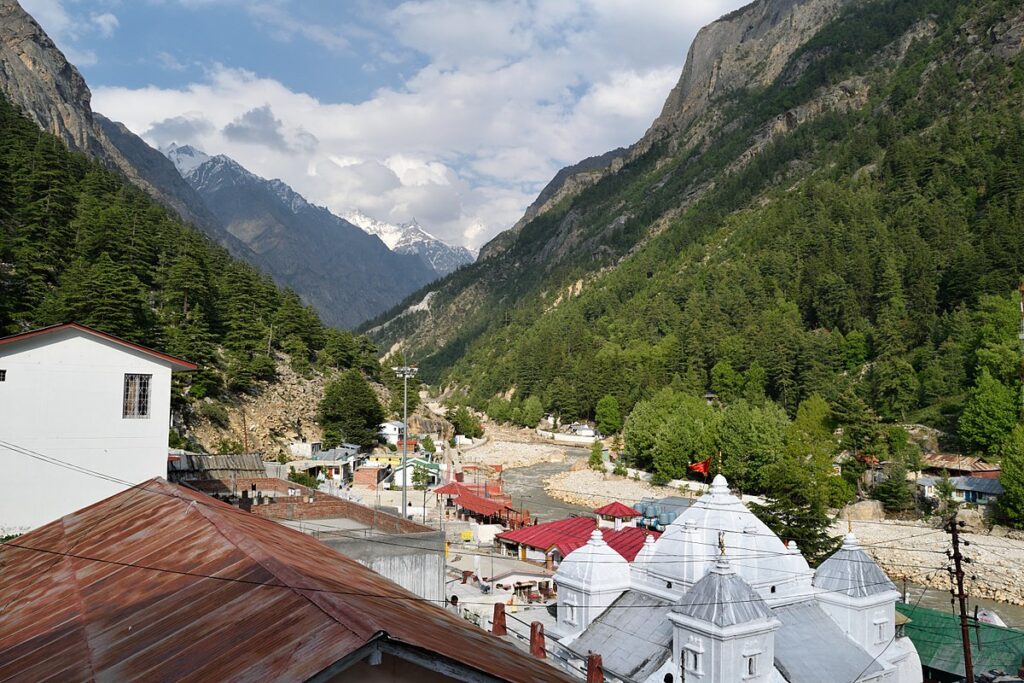
Road Conditions and Transportation
The route from Rishikesh to Gangotri (NH108) presents significant challenges during winter:
Key Sections and Risks:
- Rishikesh to Uttarkashi (180 km): Generally remains open but requires snow chains. Landslide risks increase after snowmelt.
- Uttarkashi to Gangotri (100 km): Becomes increasingly difficult; often closes by mid-November.
- Gangotri to Gaumukh (18 km trek): Completely closed; snow depth exceeds 3 meters in most areas.
Transportation Options:
- Private Vehicles: Only recommended for experienced mountain drivers with winter tires and emergency supplies. Most rental agencies prohibit winter travel to these areas.
- State Transport Buses: Services to Uttarkashi continue but become unreliable after November. No services beyond Uttarkashi.
- Helicopter Services: Operate sporadically from Dehradun or Srinagar to Gangotri helipad when weather permits (approximately 10-15 days per winter season).
- Trekking: Not advised due to avalanche risks, deep snow, and lack of support infrastructure.
Essential Preparations for Winter Travel
Clothing Requirements:
- Base Layer: Moisture-wicking thermal underwear (wool or synthetic; avoid cotton)
- Mid Layer: Fleece or down insulation (2-3 layers recommended)
- Outer Layer: Windproof, waterproof shell with ventilation options
- Extremities Protection: Insulated, waterproof boots (rated to -20°C); mittens (warmer than gloves); balaclava or neck gaiter
- Special Considerations: Sunglasses with UV protection (snow blindness risk); hand and foot warmers; lip balm with SPF
Health and Safety:
- Altitude Acclimatization: Spend 24-48 hours in Uttarkashi (1,150m) before proceeding higher
- Medical Consultation: Discuss altitude sickness prevention with a physician familiar with high-altitude medicine
- Emergency Supplies: Carry oxygen canisters (available in Rishikesh), first-aid kit, satellite phone or emergency beacon
- Hydration Strategy: Drink 3-4 liters of fluids daily; warm beverages preferred
- Nutrition Planning: High-calorie, easily digestible foods; avoid heavy meals that strain digestion at altitude
Documentation and Permits:
- Indian Citizens: No special permits required for Mukhba or Uttarkashi
- Foreign Nationals: Inner Line Permit required (obtained in Rishikesh)
- Registration: Mandatory registration with local police upon arrival in Uttarkashi
- Travel Insurance: Must cover high-altitude emergencies and helicopter evacuation
Critical Safety Considerations
Avalanche Awareness:
- The Gangotri region experiences approximately 10-15 significant avalanches annually
- Most occur between December and February during/after heavy snowfall
- Avoid traveling during or immediately after snowstorms
- Stay on established routes; never venture off-trail in snow-covered terrain
Weather Monitoring:
- Check India Meteorological Department (IMD) forecasts daily
- Monitor local weather stations in Uttarkashi and Gangotri
- Understand weather warning systems (color-coded alerts)
- Recognize local indicators: sudden temperature drops, wind shifts, cloud formations
Emergency Protocols:
- Know the location of the nearest medical facility (Uttarkashi has a primary health center)
- Carry emergency contact numbers for Uttarakhand Disaster Management
- Understand evacuation procedures (helicopter availability, ground rescue)
- Establish check-in protocols with family/friends
Planning Your Journey: Gangotri Tour Package From Delhi
Why a Specialized Winter Package Matters
Organizing winter logistics independently presents significant challenges that make a Gangotri tour package from Delhi not merely convenient but essential for safety and meaningful experience. The complexities of winter travel—unpredictable weather, limited infrastructure, and specialized knowledge requirements—demand professional expertise that independent travelers often lack.
A reputable winter-specific package provides:
- Local Expertise: Guides with years of winter mountain experience
- Safety Infrastructure: Emergency equipment and protocols
- Logistical Mastery: Real-time weather monitoring and route adjustments
- Cultural Access: Connections to winter rituals and local traditions
- Regulatory Compliance: Knowledge of evolving permit requirements
Unlike summer packages, winter itineraries require flexibility, contingency planning, and specialized equipment—elements that distinguish professional operators from generic tour companies.
What a Quality Winter Package Includes
| Delhi-Rishikesh Transfer | Climate-controlled vehicle with snow chains; avoids night driving on mountain roads | Confirm vehicle type (4×4 essential), driver experience, and safety features |
| Accommodation | Heated rooms in Uttarkashi/Mukhba (not Gangotri, which shuts down) | Verify heating type (electric vs. wood-burning), backup power, and emergency provisions |
| Expert Guidance | Local guides trained in winter safety, avalanche awareness, and emergency protocols | Check guide certifications, winter experience duration, and client ratios |
| Flexible Itinerary | Built-in buffer days for weather delays; no rigid schedules | Confirm cancellation policies, alternative activities, and decision-making protocols |
| Mukhba Focus | Emphasis on temple rituals, cultural immersion, and nearby sites like Harsil | Ensure ritual participation opportunities and cultural context |
| Emergency Support | Satellite phones, oxygen, and pre-identified medical facilities | Verify equipment quality, staff training, and evacuation procedures |
| Winter-Specific Gear | Access to high-quality cold-weather equipment | Confirm what’s provided vs. required to bring |
Evaluating Package Providers: Critical Questions
When selecting a Gangotri tour package from Delhi, ask these essential questions:
Operational Expertise:
- “How many winter seasons have you operated in Gangotri?”
- “What percentage of your staff has winter-specific training?”
- “Can you provide references from previous winter travelers?”
Safety Protocols:
- “What’s your emergency evacuation procedure?”
- “How do you monitor weather conditions in real-time?”
- “What medical training do your guides possess?”
Logistical Capabilities:
- “What’s your typical group size for winter tours?”
- “How do you handle accommodation if weather delays occur?”
- “What’s your policy when helicopter services are canceled?”
Cultural Integration:
- “How do you facilitate meaningful engagement with winter rituals?”
- “Do you include opportunities to interact with local winter communities?”
- “What cultural context do you provide for the Uvaar ceremony and winter worship?”
Sample Winter Itinerary (5 Days)
Day 1: Delhi to Rishikesh (280 km / 7 hours)
- Morning departure from Delhi with experienced driver
- Scenic drive through Shivalik foothills
- Overnight in Rishikesh with orientation on winter travel
- Critical Check: Review weather forecast and adjust plans as needed
Day 2: Rishikesh to Uttarkashi (180 km / 6 hours)
- Gradual ascent with acclimatization stops
- Visit Devprayag (confluence of Alaknanda and Bhagirathi)
- Arrive Uttarkashi; check into heated accommodation
- Evening briefing on winter safety and itinerary
Day 3: Uttarkashi to Mukhba (35 km / 2 hours)
- Scenic drive through snow-dusted landscapes
- Stop at Harsil (village on the Bhagirathi River)
- Arrive Mukhba; check into village guesthouse
- Attend evening aarti at the winter temple
- Winter Special: Candlelight storytelling session with local priests
Day 4: Mukhba Exploration
- Morning temple rituals participation
- Guided walk to nearby winter villages
- Visit local craft centers (wool weaving, wood carving)
- Optional helicopter flight to Gangotri viewpoint (weather permitting)
- Evening cultural program featuring traditional Garhwali music
Day 5: Return Journey
- Final temple visit and blessings
- Scenic return via Tehri route
- Stop at Dharali for panoramic mountain views
- Evening arrival in Rishikesh; overnight before Delhi departure
Note: This itinerary includes two buffer days for weather delays, with alternative indoor activities planned for poor conditions.
Cost Considerations and Value Assessment
Winter packages command a premium due to specialized requirements, but understanding what you’re paying for is crucial:
Price Range:
- Budget: ₹17,000-24,000 per person (basic accommodations, limited flexibility)
- Standard: ₹27,000-34,000 per person (quality heated accommodations, expert guides, moderate flexibility)
- Premium: ₹38,000+ per person (private accommodations, specialized equipment, high guide-to-traveler ratio)
Value Indicators:
- Staff-to-Traveler Ratio: Should not exceed 1:6 in winter conditions
- Equipment Quality: Premium packages provide high-end cold-weather gear
- Medical Preparedness: Includes oxygen, first-aid training, and evacuation planning
- Cultural Access: Opportunities to participate in rituals, not just observe
- Flexibility: Clear policies for weather-related changes
Red Flags to Avoid:
- Packages significantly cheaper than market rate
- Vague safety protocols
- No winter-specific itinerary details
- “Guaranteed temple darshan” claims
- Lack of verifiable winter experience
Accommodation and Facilities in Winter
Understanding Winter Accommodation Realities
The hospitality infrastructure around Gangotri undergoes dramatic seasonal shifts. While summer sees numerous guesthouses and hotels operating along the pilgrimage route, winter brings significant closures:
Gangotri (Temple Town):
- Completely closed by mid-November
- No operational accommodations
- Emergency shelters only for authorized personnel
Gomukh (Glacier Base):
- Inaccessible after October
- No facilities during winter
Uttarkashi:
- Primary winter accommodation hub
- Approximately 20-25 operational properties
- Range from budget guesthouses to premium resorts
- Most offer heated rooms and reliable power
Mukhba:
- Spiritual and accommodation center for winter
- Temple guesthouses provide basic but clean accommodations
- Limited commercial options; primarily community-run facilities
- Intimate atmosphere with ritual participation opportunities
Types of Winter Accommodations
Temple Guesthouses:
- Operated by temple authorities in Mukhba
- Basic but clean rooms with shared facilities
- Includes participation in daily rituals
- Budget-friendly (₹700-1,400/night)
- Ideal for: Spiritual seekers prioritizing cultural immersion
Heritage Properties:
- Converted traditional homes with modern amenities
- Wood-burning stoves for authentic warmth
- Local family management with cultural insights
- Mid-range pricing (₹2,400-3,900/night)
- Ideal for: Travelers seeking authentic local experience
Premium Resorts:
- Modern facilities with backup heating systems
- Restaurant service with seasonal menus
- Emergency equipment and protocols
- Higher pricing (₹4,900-7,800/night)
- Ideal for: Families and those prioritizing comfort
Specialized Winter Lodges:
- Designed specifically for cold-weather travel
- Advanced heating systems (radiant floor heating)
- Winter activity planning and equipment
- Highest pricing (₹7,900-11,900/night)
- Ideal for: Photographers and adventure travelers
Essential Accommodation Features for Winter
When evaluating options, prioritize these winter-specific features:
Heating Systems:
- Electric heaters (common but vulnerable to power outages)
- Wood-burning stoves (traditional, reliable, but require maintenance)
- Radiant floor heating (most comfortable, found in premium properties)
- Backup heating (essential; verify availability)
Power Reliability:
- Generator backup (critical for medical equipment)
- Battery systems for essential lighting
- Power cut frequency (ask about historical patterns)
- Charging facilities for electronic devices
Dining Options:
- Hot meal availability (multiple times daily)
- Dietary accommodation capabilities
- Emergency food stores
- Water purification systems
Safety Infrastructure:
- Emergency communication equipment
- First-aid facilities
- Staff trained in winter emergencies
- Evacuation protocols
Dining and Culinary Experience
Winter dining in the Gangotri region offers a unique culinary experience centered around warmth and sustenance:
Traditional Winter Cuisine:
- Bhatt ki Churdkani: Black soybean curry with local spices
- Gahat ki Dal: Horse gram lentils known for warming properties
- Bafat: Spiced potato pancakes served with honey
- Jhangora ki Kheer: Barnyard millet pudding with nuts
Beverages:
- Adrak Wali Chai: Ginger tea with cardamom
- Thukpa: Tibetan-style noodle soup
- Local Honey: Served with warm water for throat relief
- Herbal Infusions: Made from mountain herbs
Dining Considerations:
- Meal times may follow local rhythms (earlier dinners)
- Vegetarian options dominate (reflecting pilgrimage traditions)
- Limited fresh produce in deep winter
- Water must be boiled or purified
Special Dietary Needs:
- Communicate requirements in advance
- Premium packages often accommodate special diets
- Carry emergency snacks for dietary restrictions
- Local alternatives may differ from expectations
Safety Considerations and Preparations
Understanding Mountain Weather Patterns
The Gangotri region experiences some of the most volatile weather patterns in the Himalayas. Understanding these patterns is critical for safety:
Winter Weather Characteristics:
- Temperature Inversions: Cold air sinks into valleys while warmer air sits above, creating prolonged freezing conditions at ground level
- Snowfall Patterns: Most significant snow occurs during western disturbances (every 5-7 days)
- Visibility Challenges: Frequent fog and whiteout conditions during/after snowfall
- Wind Patterns: Strong downslope winds that accelerate snowmelt and avalanche risks
Seasonal Weather Indicators:
- Pre-Snowfall: Sudden temperature rise, high cirrus clouds, still air
- During Snowfall: Steady temperature, consistent wind direction, reduced visibility
- Post-Snowfall: Clear skies, sharp temperature drop, calm conditions
Local Weather Wisdom:
- Animal Behavior: Birds flying low indicates approaching storms
- Plant Indicators: Pine cones closing signals moisture in the air
- Mountain Sounds: Changes in wind patterns through valleys
- Cloud Formations: Specific shapes that predict weather changes
Comprehensive Safety Planning
Pre-Travel Preparation:
- Medical Checkup: Comprehensive evaluation focusing on respiratory and cardiovascular health
- Vaccinations: Ensure routine vaccinations are current; consider altitude-specific advice
- Insurance Verification: Confirm coverage for high-altitude emergencies and evacuation
- Emergency Contacts: Establish clear communication protocols with family
Packing Essentials:
- Technical Gear: GPS device, satellite communicator, headlamp with extra batteries
- Medical Supplies: Personal medications, altitude sickness medication, blister care
- Emergency Kit: Firestarter, emergency blanket, high-calorie snacks
- Communication: Fully charged power bank, local SIM card
On-Site Safety Protocols:
- Daily Briefings: Weather updates and safety reminders
- Buddy System: Never travel alone in snow conditions
- Check-In Schedule: Regular communication with base
- Turn-Around Points: Pre-determined limits based on conditions
Altitude Sickness Prevention and Management
Understanding Acute Mountain Sickness (AMS):
- Occurs above 2,500 meters; Gangotri region ranges from 1,000-3,100 meters
- Symptoms: Headache, nausea, dizziness, fatigue, sleep disturbance
- Risk factors: Rapid ascent, dehydration, exertion, pre-existing conditions
Prevention Strategies:
- Gradual Ascent: Limit elevation gain to 300-500 meters per day above 3,000m
- Hydration: Drink 3-4 liters of fluids daily; avoid alcohol and caffeine
- Medication: Acetazolamide (Diamox) under medical supervision
- Activity Management: Balance exertion with rest; avoid overexertion
Recognition and Response:
- Mild AMS: Rest, hydration, pain relief; monitor for progression
- Moderate AMS: Descend 500-1,000 meters; medical evaluation
- Severe AMS: Immediate descent; oxygen administration; emergency evacuation
Local Medical Resources:
- Uttarkashi: Primary Health Center with basic facilities
- Tehri: District hospital with oxygen and limited specialist care
- Rishikesh: Advanced medical facilities including high-altitude specialists
- Helicopter Evacuation: Available from Uttarkashi/Mukhba to Rishikesh (45-60 minutes)
Avalanche Awareness and Response
Understanding Avalanche Risks:
- Primary Trigger: Heavy snowfall followed by rapid warming or wind loading
- High-Risk Periods: During/after snowstorms, during rapid warming
- Danger Zones: Steep slopes (30-45 degrees), convex rolls, gullies
- Regional Patterns: Most common December-February; decreasing in March-April
Risk Assessment:
- Snow Stability Tests: Simple field tests travelers can learn
- Terrain Evaluation: Identifying safe travel corridors
- Weather Monitoring: Recognizing conditions that increase risk
- Local Knowledge: Consulting with experienced guides
Emergency Response:
- If Caught: Try to move to the side of the avalanche path
- If Buried: Create an air pocket; conserve energy; signal when quiet
- Rescue: Carry avalanche transceivers; practice rescue techniques
- Reporting: Know emergency contact numbers for Uttarakhand Disaster Management
Local Culture and Traditions During Winter
The Living Calendar: How Communities Adapt
The seasonal closure of Gangotri Temple isn’t merely a religious practice but a reflection of how local communities have adapted to mountain rhythms over centuries. The Garhwali people operate according to a sophisticated ecological calendar that recognizes winter not as an interruption but as an essential phase in the annual cycle.
Winter Community Activities:
- Craft Production: Wool weaving, wood carving, and metalwork intensify during winter months
- Storytelling Traditions: Elders share myths, legends, and historical accounts
- Ritual Preparation: Crafting ritual items for the upcoming pilgrimage season
- Community Gatherings: Shared meals and cultural events in heated community spaces
Agricultural Cycle:
- Post-Harvest Period: Storage and preservation of summer crops
- Winter Crops: Limited cold-hardy vegetables grown in protected spaces
- Animal Husbandry: Cattle moved to lower winter pastures
- Soil Preparation: Planning for spring planting
Spiritual Practices in Winter
The winter migration of the deity to Mukhba represents just one aspect of a rich spiritual calendar:
Daily Rituals:
- Mangala Aarti: Pre-dawn worship with specific winter mantras
- Bhoga Offering: Modified food offerings suitable for cold storage
- Evening Aarti: Extended rituals with additional lamps for warmth
- Night Protection: Special chants for safeguarding the deity during extreme cold
Special Winter Observances:
- Makar Sankranti (January 14): Festival marking the sun’s northward journey
- Shivaratri Preparations: Winter months dedicated to temple readiness
- Local Deity Worship: Increased focus on village deities during closure period
- Ancestral Rituals: Honoring ancestors through specific winter ceremonies
Priestly Traditions:
- Winter Attire for Deity: Special woolen garments for the idol
- Modified Ritual Procedures: Adjusted for indoor worship spaces
- Training Period: Junior priests receive intensive instruction
- Scriptural Study: Deep engagement with religious texts during quiet months
Cultural Immersion Opportunities
For winter travelers, these traditions offer unique engagement possibilities:
Participatory Experiences:
- Ritual Assistance: Helping with lamp preparation or offering arrangements
- Craft Workshops: Learning wool weaving or wood carving techniques
- Culinary Traditions: Participating in winter food preparation
- Story Circles: Joining evening storytelling sessions with elders
Respectful Observation:
- Temple Rituals: Observing modified winter worship practices
- Community Events: Attending seasonal festivals with permission
- Daily Life: Understanding how locals adapt to winter conditions
- Environmental Stewardship: Learning traditional ecological knowledge
Cultural Exchange Guidelines:
- Permission First: Always ask before photographing people or rituals
- Dress Modestly: Respect local customs regarding attire
- Gift Giving: Appropriate offerings for hosts (avoid money)
- Language Effort: Learning basic Garhwali phrases shows respect
Personal Accounts and Experiences
Voices from the Snow: Winter Traveler Reflections
The Photographer’s Perspective: “I came for the images but stayed for the silence. In February, I stood at the Gangotri helipad during a brief weather window. The temple emerged from swirling snow like a vision—stone spires dusted with fresh powder, the glacier snout barely visible in the distance. What struck me wasn’t the visual beauty alone but the profound silence. No crowds, no chatter, just the wind sculpting snow. I captured images I’d dreamed of, but more importantly, I learned to see differently—to notice the subtle shifts in light, the patterns in snowfall, the way mountains breathe through storms. Winter Gangotri isn’t a place you photograph; it’s a state of being you experience through your lens.” — Amit Verma, Professional Photographer
The Spiritual Seeker’s Journey: “My first winter in Mukhba changed everything. Without the goal of reaching Gangotri Temple, I had to confront why I was traveling. In the village temple’s candlelight, listening to the priests’ chants echo in the wooden chamber, I discovered something unexpected: the deity’s presence felt more immediate here than it ever had in the bustling summer temple. The slower pace, the intimate rituals, the way the community gathered around the wood stove after evening prayers—it revealed that divinity isn’t confined to a single location but flows through the entire rhythm of life. Now I return every winter, not as a pilgrim racing to a destination, but as a guest welcomed into a sacred cycle.” — Priya Sharma, Yoga Instructor
The Family Experience: “Taking my children (ages 11 and 13) to Mukhba in January was either brilliant or insane—probably both. We worried they’d be bored without the ‘real’ temple, but winter offered unexpected gifts. They learned to read snow patterns with local kids, helped prepare ritual offerings, and discovered that cold weather adventures could be magical (building snow forts, drinking hot adrak wali chai). Most importantly, they experienced spirituality not as a checklist but as a living tradition—seeing how the community adapts rituals to seasons, how elders share stories by firelight, how faith persists through silence. They returned home with snow in their hearts, not just snow photos.” — Rajiv Mehta, Educator
The Researcher’s Insights: “My ethnographic study of winter rituals in Mukhba revealed layers of cultural resilience. The Uvaar ceremony isn’t merely practical; it embodies sophisticated ecological knowledge. The specific mantras chanted during the deity’s journey correspond to seasonal transitions documented in ancient texts. Winter worship procedures incorporate subtle adaptations that maintain ritual integrity while acknowledging environmental constraints. What outsiders might see as ‘closure’ is actually a complex system of continuity—preserving sacred energy through seasonal change. This wisdom, developed over centuries, offers valuable insights for contemporary discussions about climate adaptation.” — Dr. Anjali Thapliyal, Cultural Anthropologist
Common Themes in Winter Experiences
Analysis of numerous winter traveler accounts reveals consistent themes:
The Gift of Slowness: Without the pressure to reach the temple, travelers consistently report deeper engagement with each moment—the texture of snow, the rhythm of temple bells, the pace of mountain life. This unhurried approach fosters mindfulness often lost in conventional pilgrimage.
Redefining Sacred Space: Winter forces a reconsideration of where divinity resides. Without access to the primary temple, travelers discover sacredness in unexpected places—the frozen river, a village hearth, the journey itself—expanding their understanding of spiritual geography.
Community Connection: The smaller scale of winter travel facilitates genuine connections with local communities. Travelers report meaningful interactions impossible during summer’s crowds, creating relationships that often continue beyond the journey.
Personal Transformation: The combination of physical challenge, sensory deprivation, and spiritual focus creates conditions for profound personal insights. Many describe winter Gangotri as a catalyst for significant life changes or renewed purpose.
Frequently Asked Questions (FAQs)
Planning and Logistics
Q: Is Gangotri accessible in December? A: The main temple remains closed, but Mukhba (where the deity resides) is fully accessible. Gangotri may be reachable early in December if roads remain clear, but access becomes increasingly difficult as the month progresses. Helicopter services operate sporadically when weather permits, offering distant views of the snow-covered temple and glacier. Most travelers focus on Mukhba and Uttarkashi during December, with an emphasis on cultural and spiritual experiences rather than physical access to Gangotri itself.
Q: Where is Gangotri located relative to major cities? A: Gangotri lies approximately 400 km northeast of Delhi via the most common route (Delhi-Haridwar-Rishikesh-Uttarkashi-Gangotri). The road journey takes 12-14 hours to Rishikesh, followed by 6-7 hours to Uttarkashi, and then 3-4 hours to Gangotri (when accessible). By air, the nearest airport is Jolly Grant in Dehradun (230 km from Rishikesh), with connecting road transport required. The temple’s remote location in the Garhwal Himalayas contributes to its winter inaccessibility.
Q: Can I book a Gangotri tour package from Delhi for January? A: Yes, but with important caveats. Reputable operators offer January packages focused on Mukhba, Uttarkashi, and nearby cultural sites—not the Gangotri Temple itself. These packages emphasize winter-specific experiences: participation in modified rituals, cultural immersion, and snow-covered landscapes. Confirm that your package includes winter-appropriate accommodations (heated rooms), emergency protocols, and flexible scheduling for weather delays. Avoid operators promising “temple darshan,” as this is impossible during winter closure.
Q: What’s the best time to visit Gangotri in winter? A: February through early March generally offers the most favorable conditions, balancing snow coverage with improved accessibility:
- Late January: Deepest snow, most challenging conditions
- February: Gradual improvement; occasional clear days
- Early March: Increasing accessibility; snow still abundant
- Late March: Snow begins melting; road clearance operations commence
Each period offers distinct advantages—deep snow for photography in January-February, improving conditions for travel in February-March. Your ideal timing depends on whether you prioritize maximum snow coverage or ease of travel.
Safety and Preparation
Q: What’s the biggest risk in winter travel to Gangotri? A: The primary risks are avalanches and sudden weather changes, not extreme cold as many assume. The region experiences significant avalanche activity between December and February, particularly during and after snowstorms. Sudden whiteout conditions can disorient even experienced travelers. Mitigation requires:
- Traveling with experienced guides who understand avalanche terrain
- Monitoring weather forecasts through reliable channels
- Carrying emergency communication equipment
- Following local safety protocols without exception
Q: How should I prepare physically for winter travel here? A: Physical preparation should focus on:
- Cardiovascular fitness: Hiking at altitude requires strong heart and lungs
- Cold adaptation: Gradual exposure to cold temperatures before travel
- Balance and stability: Snow walking demands different muscle engagement
- Hydration discipline: Dry mountain air accelerates fluid loss
Begin training 8-12 weeks before travel, incorporating:
- Altitude simulation (if possible)
- Winter hiking on local trails
- Breathing exercises for high altitude
- Strength training for core and legs
Q: What medical preparations are essential? A: Critical medical preparations include:
- Pre-travel consultation: With physician experienced in high-altitude medicine
- Altitude medication: Acetazolamide (Diamox) prescription if recommended
- Personal medications: Extra supply of regular medications
- Emergency equipment: Portable oxygen canisters (available in Rishikesh)
- Insurance verification: Coverage for high-altitude emergencies and evacuation
Special considerations for pre-existing conditions:
- Respiratory issues: May worsen at altitude; consult specialist
- Cardiovascular conditions: Requires careful evaluation
- Diabetes: Cold affects insulin absorption; adjust plan
- Arthritis: Cold may exacerbate symptoms; discuss with doctor
Cultural and Spiritual Considerations
Q: What rituals can I participate in during winter? A: While the main temple is closed, numerous meaningful rituals continue:
- Daily Aartis: In Mukhba’s village temple (morning and evening)
- Bhoga Offerings: Preparation and presentation of food offerings
- Rudra Abhishek: Special Shiva worship ceremonies
- Scripture Recitation: Community readings of sacred texts
- Winter-Specific Rituals: Adapted procedures for indoor worship
Participation guidelines:
- Observe first: Understand protocol before joining
- Ask permission: For specific ritual involvement
- Dress appropriately: Modest clothing required
- Follow guidance: Of temple priests and staff
Q: How do locals view winter travelers? A: Local communities generally welcome respectful winter travelers who:
- Understand and honor the seasonal closure
- Participate in community life without disruption
- Show genuine interest in cultural traditions
- Respect local customs and wisdom
Common misconceptions to avoid:
- Viewing winter as “off-season” rather than a distinct phase
- Expecting summer-level services and infrastructure
- Treating the region as merely a backdrop for photography
- Ignoring local safety advice in favor of personal goals
Q: Can I perform personal spiritual practices in the area? A: Yes, with important considerations:
- Temple Areas: Follow specific protocols; ask permission for personal rituals
- Natural Sites: Many locations (like riverbanks) welcome quiet meditation
- Community Spaces: Participate in shared spiritual activities
- Private Accommodations: Ideal for personal practices
Guidelines for respectful practice:
- Minimal impact: Leave no physical traces
- Quiet observance: Avoid disrupting others
- Cultural sensitivity: Adapt practices to local norms
- Local guidance: Consult with knowledgeable community members
Practical Considerations
Q: What should I pack for a winter Gangotri trip? A: Essential packing list:
- Base Layers: Merino wool or synthetic thermal underwear (2 sets)
- Mid Layers: Fleece or down insulation (2-3 pieces)
- Outer Shell: Waterproof, windproof jacket and pants
- Footwear: Insulated, waterproof boots (rated to -20°C)
- Accessories: Balaclava, neck gaiter, mittens, warm hat
- Technical Gear: Sunglasses with UV protection, headlamp, power bank
- Personal Items: High-SPF lip balm, moisturizer, medications
Specialized items to consider:
- Hand and foot warmers
- Collapsible water bottle (insulated)
- Compact emergency blanket
- Small backpack for day trips
- Journal for reflections
Q: How do I stay warm during temple visits? A: Practical warmth strategies:
- Layering: Wear multiple thin layers rather than one thick layer
- Core Focus: Keep torso warm; extremities will follow
- Movement: Gentle movement during extended standing
- Thermal Accessories: Heat packs in pockets or against core
- Hydration: Warm beverages maintain internal temperature
Temple-specific considerations:
- Sitting Areas: Carry a small cushion for cold surfaces
- Footwear: Remove shoes at temple entrances; wear warm socks
- Timing: Visit during warmer daylight hours when possible
- Group Warmth: Travel with others; shared body heat helps
Q: What communication options exist in remote areas? A: Communication realities:
- Mobile Coverage: Limited to Uttarkashi and Mukhba; unreliable elsewhere
- Satellite Phones: Available through premium tour operators
- Emergency Radios: Carried by professional guides
- Community Resources: Temple offices may have landlines
Communication strategy:
- Pre-arranged Check-ins: With family at specific times
- Local Contacts: Obtain numbers of guide and accommodation
- Emergency Protocols: Understand how to request help
- Technology Limits: Assume no connectivity in remote areas




